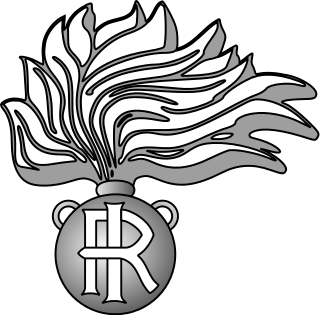Servizio Informazioni Operative e Situazione (Operative Informations and Situation Service) was an Italian military intelligence and security service serving from 1949 until 1997. Its main duty was safeguarding the internal security of military bases and its personnel and military intelligence activities against enemy and foreign forces, especially through SIGINT activities.
It was composed of three divisions: the SIOS Marina ("SIOS Navy"), the SIOS Aeronautica ("SIOS Air Force") and the SIOS Esercito ("SIOS Army"). Some SIOS personnel came from the ranks of the Arma dei Carabinieri (Force of Carabinieri) for the power of Military Police that the Carabinieri has. The SIOS personnel operated under the authority of the chief of staff of their respective armed forces, and they also shared coordination goals with SIFAR (then become SID and after SISMI).
Since 1998, the II Reparto informazioni e sicurezza - II RIS ("Security and Intelligence Section", not to be confused with the RIS, Reparto Investigazioni Scientifiche, "Scientific Investigation Section", the forensic science unit of the Carabinieri) and its intelligence branch: CII, Centro Intelligence Interforze ("Joint Intelligence Center"), serves at the joint level the same purposes previously attended by the SIOS.

The Carabinieri are the national gendarmerie of Italy who primarily carry out domestic and foreign policing duties. It is one of Italy's main law enforcement agencies, alongside the Polizia di Stato and the Guardia di Finanza. As with the Guardia di Finanza but in contrast to the Polizia di Stato, the Carabinieri are a military force. As the fourth branch of the Italian Armed Forces, they come under the authority of the Ministry of Defence; for activities related to inland public order and security, they functionally depend on the Ministry of the Interior. In practice, there is a significant overlap between the jurisdiction of the Polizia di Stato and Carabinieri, although both of them are contactable through 112, the European Union's Single Emergency number. Unlike the Polizia di Stato, the Carabinieri have responsibility for policing the military, and a number of members regularly participate in military missions abroad.

Military police (MP) are law enforcement agencies connected with, or part of, the military of a state. In wartime operations, the military police may support the main fighting force with force protection, convoy security, screening, rear reconnaissance, logistic traffic management, counterinsurgency, and detainee handling.
Servizio per le Informazioni e la Sicurezza Militare was the military intelligence agency of Italy from 1977–2007.

The Polizia di Stato is one of the national police forces of Italy. Alongside the Carabinieri, it is the main police force for providing police duties, primarily to cities and large towns, and with its child agencies it is also responsible for highway patrol (autostrade), railways (ferrovie), airports (aeroporti), customs as well as certain waterways, and assisting the local police forces.

Law enforcement in Italy is centralized on a national level, carried out by multiple national forces, helped by few limited local agencies. The Italian law enforcement system is considered complex, with multiple police forces and other agencies taking part in different duties. Policing in the Italian system refers to the duties of "full-powered officers" coming from the four national main forces: Polizia di Stato, Carabinieri, Polizia Penitenziaria and Guardia di Finanza. While the duties of these four corps' include investigating and arresting, other local forces carry out limited duties.

The Gruppo di Intervento Speciale (GIS) is the special forces unit of the Carabinieri. The Carabinieri, a branch of the Italian Armed Forces responsible for both military and civil policing, formed GIS in 1978 as a police tactical unit. In 2004, GIS assumed a special operations role, evolving to a special forces unit, in addition to the police tactical unit role, becoming part of the Comando interforze per le Operazioni delle Forze Speciali (COFS.

The Italian Special Forces include special forces units from several branches of the Italian Armed Forces: the Esercito Italiano (Army), the Marina Militare (Navy), the Aeronautica Militare and the Arma dei Carabinieri (Gendarmerie).
RIS may refer to:

The Palestinian National Security Forces are the paramilitary security forces of the Palestinian National Authority. The name may either refer to all National Security Forces, including some special services but not including the Interior Security Forces, the Presidential Guard and General Intelligence, or refer to the main force within the National Security Forces. Since the signing of the Oslo Accords, these forces operate in areas controlled by the PNA. In 2003, the organizations were merged into the Palestinian Security Services.
Italian intelligence agencies are the intelligence agencies of Italy. Currently, the Italian intelligence agencies are the Agenzia Informazioni e Sicurezza Esterna (AISE), focusing on foreign intelligence, and the Agenzia Informazioni e Sicurezza Interna (AISI), focusing on internal security. They form part of the Department of Information for Security, which in turn is part of the Presidency of the Council of Ministers. The agencies have been reorganized multiple times since the birth of the Italian Republic in 1946 to attempt to increase effectiveness.
The 1st Carabinieri Paratroopers Regiment "Tuscania" is a special operations unit of the Italian Carabinieri. Together with the 7th Carabinieri Regiment in Laives, the 13th Carabinieri Regiment in Gorizia, and the Special Intervention Group it forms the 2nd Carabinieri Mobile Brigade. The regiment is based in Livorno, and has approximately 550 personnel.

The Agenzia Informazioni e Sicurezza Esterna is the foreign intelligence service of Italy.
The Italian Military Information Service was the military intelligence organization for the Royal Army of the Kingdom of Italy from 1925 until 1946, and of the Italian Republic until 1949. The SIM was Fascist dictator Benito Mussolini's equivalent to the German Abwehr. In the early years of the war, the SIM scored important intelligence successes. Rommel’s successful military operations in North Africa in 1942 were substantially facilitated by the SIM through the securing of the U.S. Black Code used by Colonel Bonner Fellers to communicate plans for British military operations to his Headquarters in Washington.

The Italian Naval Aviation is the naval air component of the Italian Navy composed of around 2000 men and women and 69 aircraft and helicopters.

The 2nd Carabinieri Mobile Brigade, based in Livorno, is the Carabinieri formation dedicated to military missions abroad, including military police tasks. It employs the 7th Carabinieri Regiment "Trentino-Alto Adige", the 13th Carabinieri Regiment "Friuli-Venezia Giulia", the 1st Parachute Carabinieri Regiment "Tuscania" and the Gruppo di intervento speciale.

Fulvio Martini was an Italian Navy admiral and intelligence officer. He was the head of Military Security and Intelligence between 5 May 1984 and 26 February 1991.
The Network Operations Command is an Italian cyberwarfare Joint military unit. Until its merger with the Comando C4 Difesa in 2020, it was called Joint Cybernetic Operations Command
The following is the structure of the Italian Navy as of June 2020. It is considered a multiregional and a blue-water navy.
Comando Supremo was the highest command echelon of the Italian Armed Forces between June 1941 and May 1945. Its predecessor, the Stato Maggiore Generale, was a purely advisory body with no direct control of the several branches of the armed forces and with very little staff. Created amidst the exigencies of World War II, Comando Supremo was a large organization with several departments and operational command of the armed forces on the active fronts. At the end of the war, it was reduced to a purely advisory role again.

The 9th Cybernetic Security Regiment "Rombo" is a cyber warfare unit of the Italian Army based in Cecchignola in Rome. The regiment is assigned to the Tactical Intelligence Brigade and tasked with performing cyber operations related to the defence of the army's IT networks and Command-and-Control systems, the protection of critical infrastructures and platforms and weapon systems.